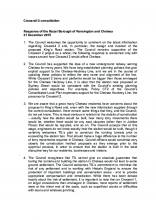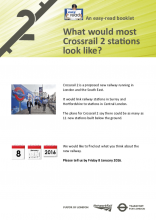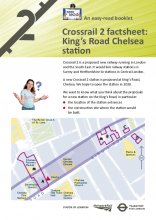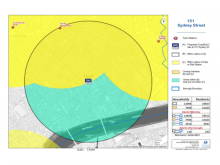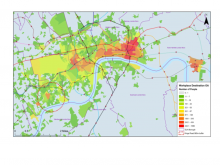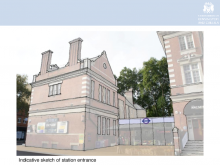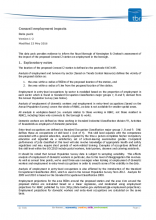Crossrail 2
On this page
Transport for London's latest public consultation ran from 27 October to 8 January
Read the results of the consultation:
Read the Council’s response to those results.
The next steps
Tfl has said that it will respond to the issues raised in the consultation over the summer.
You can view the Council’s own submission to the consultation below:
Following a request from the Kensington and Chelsea Mobility Forum, TfL has produced an EasyRead version of the consultation material on Crossrail 2 stations and for King's Road.
There have been two earlier TfL consultations
Why the Council supports a Crossrail 2 station for Chelsea
- Some parts of south west Chelsea are not well served by the underground. This new station would bring around 5,000 homes within a ten minute walk of an underground station for the first time.
- The existing underground network serving Chelsea is currently overcrowded, the planned rail and Underground upgrades will relieve congestion in the short term, but by 2031 forecasts show significant overcrowding will be evident again. This is because London's population is increasing.
- Local buses can be packed and they can also be painfully slow along the King’s Road because of traffic congestion, a bus journey from West Chelsea just to start a tube trip can take 20 minutes.
- The air quality in Chelsea is unusually poor and according to Public Health England poor air quality is a factor in one in 12 deaths in the Royal Borough. When it comes to longevity, Chelsea does well but it could be doing even better. A switch from cars, buses and taxis to Crossrail 2 would improve air quality.
- A Crossrail 2 station in Chelsea would allow local people to get to Clapham Junction in approximately three minutes, and then connect on to Gatwick and the south of England. Tottenham Court Road would be approximately six minutes away. From there, Canary Wharf will be only 12 minutes; Heathrow just 30 minutes; HS1 and HS2 would both be under ten minutes away at the new Euston St Pancras station.
- People who live in the King’s Road area most commonly work in the West End, City and Canary Wharf, being able to use Crossrail 2 would considerably reduce crowding and their journey times, improving their quality of life.
- People who benefit the local economy and community – shop workers, teachers, hospital staff - need good public transport. We know local schools are already experiencing problems retaining staff.
These are real benefits for local people.
Local people’s concerns
The Council is aware that many local people understandably have concerns about the proposed station. Some of these were raised at the recent public meeting others have been raised previously.
Timetable for the project
The current TfL consultation runs until 8 January 2016
March 2016 - National Infrastructure Commission are expected to give an indication of how they view the project
Spring 2016 – The Crossrail 2 Growth Commission report on the additional development that will be unlocked along the line
Late 2017 - Earliest date for submission of a Crossrail 2 Bill to Parliament
Construction could commence in the early 2020s and be completed by 2030
Size and location of the station
TfL have publicly stated that their objectives for a station at King’s Road are:
- to improve public transport accessibility in the Chelsea area
- to reflect the character of area
- to support local plans
The station entrance would be located between 250 King’s Road and 151 Sydney Street, as this initial sketch indicates. There would not be any over station development and the structure and facades 250 King’s Road and 151 Sydney Street would be retained. The ticket hall would be beneath, or within, 151 Sydney Street. The underground platforms will be up to 250m in length, as they will be for Crossrail 1, with a single barrel of three escalators providing access to the platforms. There would also be a ventilation shaft in a location close to Jubilee Place.
Operation of the station
TfL estimate 5,000 people per hour would use the station (3,000 exiting and 2,000 entering) during the three peak morning hours 7:00-10:00. This is comparable to the number of people currently using Sloane Square station.
The station is likely to operate in line with the rest of the underground system so if this became a 24 hr service on Fridays and Saturdays then so would Crossrail 2.
Claims that a station might increase littering, loitering and other antisocial behaviour cannot be substantiated at this stage. Sloane Square Tube Station currently serves a similar number of people in the area and there is very little such anti-social behaviour. Also there would be fewer people living in the immediate vicinity of the station site, on the corner of Sydney Street and King’s Road, than at Dovehouse Street as previously proposed, so the impact on residents would be less.
Construction impact on the amenity of Chelsea
Understandably people want information about how the line and the station would be constructed and how this could affect their daily lives. Some of this information simply isn’t available yet because the project is at an early stage.
We do know construction is likely to take 5-8 years. The sites required to construct the station have been identified they are:
- 2, 3 and 5 Jubilee Place
- 140-142 King's Road
- 148-150 King's Road
- 73-77 King’s Road
- Chelsea Farmers’ Market 125-135 Sydney Street
- 151 Sydney Street
- 250 King’s Road
The total area of these sites is around a third smaller than the sites identified in the March 2015 safeguarding.
Jubilee Place is the only temporary road closure shown in TfL's current plans. TfL will be as keen as the Council to keep the King’s Road open because it is a busy bus route and serves a valuable role in the operation of the local road network.
Property blight
There is evidence that Crossrail1 has a positive impact on property prices during construction. Property prices in Chelsea are already very high so the uplift is not likely to be as great but, on the evidence of Crossrail 1, there is no reason to think that property prices would fall.
Property owners in safeguarded areas would be able to make a claim for statutory blight if they meet certain conditions.
Is there a transport case for the station?
Unfortunately the way that business cases for transport are calculated means that any stop on the line adds journey time costs per passenger so the most cost effective solution is always a service running from A to B stopping nowhere else. But this is not how underground networks operate, they need to transport people to and from many different locations.
The argument that there is no transport case for the station ignores the fact that much of Chelsea lies more than a ten minute walk from a station, and journey times to increasingly important destinations like Canary Warf will often be much quicker using Crossrail 2 than existing lines. TfL's forecasting shows that there would be a healthy demand for people to use a station if it were there.
Without a Crossrail 2 station at Chelsea those who rely on buses or cars will most likely find their journeys even slower in twenty years’ time. As London’s growth increases, demand on the District line will continue to increase, and Sloane Square and South Kensington stations will face considerable operational constraints.
A strategic cost benefit analysis has been produced looking at the overall benefits of the line.
How can a £1bn station be funded without any associated development?
The Crossrail 2 project is estimated to be around £900m more expensive with the inclusion of the station at King’s Road. This includes a large allocation for risk, as do all infrastructure projects, so the predicted actual cost is much lower.
More than half of Crossrail 2’s funding will come from a variety of London-wide sources that were also also used to fund Crossrail 1. TfL does not require each station to be funded through local development.
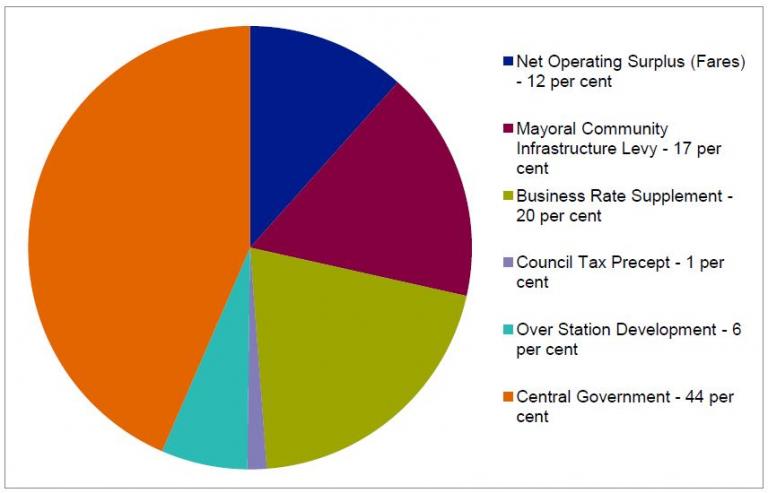
Crossrail 2 Funding
The scale of development the station will unlock
The Crossrail 2 Growth Commission is looking at the scale of development that the new line as a whole can make financially viable. TfL think this will be in the region of 200,000 homes and 200,000 jobs over 40 years. Most of these homes and jobs will be in areas that are in need of regeneration like the Lee Valley. Clearly, Chelsea is not like the Lee Valley. The figures TfL have identified for Chelsea, is around 1,000 homes (or 25 per year for the next 40 years) within a 1 km radius of the station. This is a theoretical figure based on assumptions for the line as a whole.
Loss of public space and the Fire Station
TfL originally planned to use Dovehouse Green as a construction site. In response to local concerns they have revised their plans and this site will not be used for construction. Similarly, TfL have listened to concerns about demolishing the Fire Station and amended their plans so this site is not required.
Why can’t the station be further west?
In 2013, when the Crossrail 2 project was in the very early stages, the Council asked TfL to consider the pros and cons of a station further west of the Fire Station site that had been safeguarded as part of the Chelsea Hackney line since the 1990s. TfL identified a possible location in west Chelsea, but there was no clear plan for how this station would relate to the existing housing – the fear was that it would require the demolition of many homes. TfL’s 2014 consultation clearly showed more support for a station at King’s Road than west Chelsea. Moreover, such a location would have been too far west to support the majority of shops and businesses in King’s Road.
Going even further west to Imperial Wharf or Fulham Broadway would have a number of operational disadvantages, including restrictively tight curves and longer journey times for passengers between Clapham Junction and Victoria, with a knock-on reduction in the scheme’s ability to reduce congestion at existing stations.
Is Crossrail 2 the Chelsea – Hackney tube line ?
In 1989 the Central London Rail Study proposed the Chelsea Hackney Line. The route was safeguarded in 1991 (and subsequently refreshed in 2008) and forms the base alignment for the Crossrail 2 route across London.
The trains, stations and tunnels are bigger and deeper than those on conventional 'tube' lines because they are designed to meet modern requirements: to carry more people. This does not mean the stations will be any larger at ground level, or that there would be many more people using the King's Road station. As noted above, the number of passengers forecast to use the station would be similar to that for Sloane Square – fewer than at South Kensington.
However, the lines will be fully integrated with the existing tube network, in terms of ticketing and mapping.
Why don't the hospitals support a station
Clearly the Royal Brompton and the Royal Marsden Hospitals’ patients, staff and visitors would benefit considerably from better transport links. At the moment there is a particular issue over the Chelsea Farmers' Market site which TfL want to use as a construction site but which the Royal Brompton want to sell to fund redevelopment of the main hospital site. We are confident that these two public bodies can reach an agreement that meets both their objectives.
Threat to local businesses
The PWC Crossrail 2 funding report looked at incremental business rate income as a possible funding stream but it is not part of the proposed funding package. It is true that increases in footfall are likely to convert into rent and therefore business rate increases in the longer term, as business rates are driven by rents. However, this is because increased footfall represents increased business opportunities.
There are many local businesses that would be served by the proposed station. 25,000 people work in businesses located within 800m of the proposed station and 41,000 within 1km. The turnover of these businesses is £6.8 billion and £10 billion respectively.
Depth of tunnels, noise and vibration
In Chelsea the crown of the platform tunnels would be around 20metres (65ft) below ground level. This is comparable to the depth of the Piccadilly line, which is 17-23m below ground around South Kensington station. We know that HS1 already runs under north London at a similar, or shallower, depth without causing any noise problems. Evidence from Crossrail 1 suggests there would be minimal adverse noise and vibration impacts associated with tunnels at this depth. The District Line in contrast is approximately 5-10 metres below the surface.
One of the priorities for Crossrail 2 is the control of noise and vibration resulting both from the operational service and from the scheme’s construction. As the design and construction planning progresses, detailed assessments would establish the likely levels of noise and vibration, when and where impacts could occur, and how potential effects could best be controlled to acceptable levels. As the project is at a very early stage further design work will be carried out to determine the final tunnel depths and noise and vibration impact will be a consideration as part of this work.
Damage to properties
Crossrail 1 has just completed 42 km of new tunnelling under areas including Mayfair, the Barbican and Canary Wharf that did not lead to major problems with settlement and property damage. Levels of ground settlement were significantly less than expected due to the high specification of the tunnel boring machines and real time monitoring of thousands of sensors throughout the tunnelling works. Crossrail 1 also used a technique called 'compensation grouting' which minimized the effects of ground movement at certain locations that were identified as at particular risk. At this stage it is not possible to identify if compensation grouting would be needed in Chelsea.
There are some outstanding compensation claims for Soho Square on Crossrail 1 but the scale of excavation was much larger there and claims have to wait for a year to establish whether or not subsidence has occurred. TfL report that the subsidence that has been shown to date has been on the lower end of the scale - minor cracks in walls and difficulty opening windows. TfL has made financial provision for these claims and they will be settled.
The engineers designing and building Crossrail 2 will have the benefit of experience of Crossrail 1. Nevertheless, settlement assessment will be carried out and, where required, monitoring and protection measures will be put in place. If any properties do subsequently require repair, there will be systems in place to reimburse the owners. This is likely to be in the form of a Settlement Deed for property owners.
Will the decision be outside the Council’s control?
There will be several decisions on Crossrail 2:
- TfL and Network Rail have included a station at King's Road within their current proposals for Crossrail 2 as they believe it will deliver substantial local benefits. They will seek powers to build the railway before any works can start and they have not yet submitted a powers application - further work is required before they are able to do this. No final decisions on the route or station locations have yet been taken anywhere on the line.
- The design of the station would be developed by TfL in partnership with the Council who would ensure it complemented the local area. TfL are committed to working closely with the Council to achieve this, meeting regularly to discuss the design and respond to any concerns raised. The Council would have the ability to petition against any proposals it did not support - as it has done, for example, in relation to the HS2 Bill.
- Should Crossrail 2 go ahead, the Council would remain the planning authority for new developments on the King's Road. All potential new developments would still require planning permission from the Council, as they do today. It is possible for the Mayor to call-in any application but these powers are used very rarely.
Is there anything else? Let us know by emailing [email protected].
Last updated: 30 July 2025


